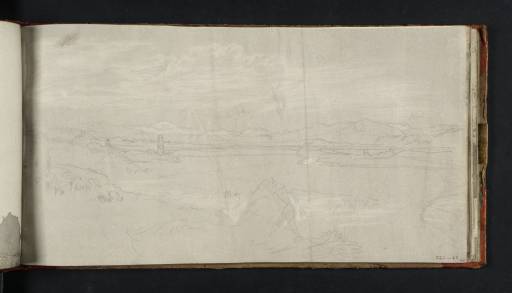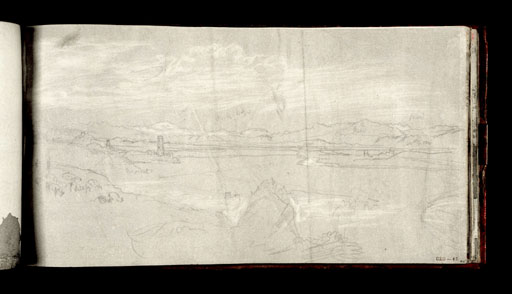Joseph Mallord William Turner The Confluence of the Tiber and Aniene Rivers with the Torre Salaria, Rome 1819
Image 1 of 2
Joseph Mallord William Turner,
The Confluence of the Tiber and Aniene Rivers with the Torre Salaria, Rome
1819
Joseph Mallord William Turner 1775–1851
Folio 40 Recto:
The Confluence of the Tiber and Aniene Rivers with the Torre Salaria, Rome 1819
D16459
Turner Bequest CXC 45
Turner Bequest CXC 45
Pencil and grey watercolour wash on white wove paper, 130 x 255 mm
Inscribed by the artist in pencil ‘Sheep’ centre left-hand edge, and ‘Snow’ and ‘Pink Haze’ above horizon in centre, and ‘Snow’ above horizon far right. Also ‘Blue’ within hills on far left and ‘Blue’ and ‘Red’ within hills centre right, and ‘B’ in centre of sketch
Inscribed by an unknown hand in pencil ‘45’ bottom right
Stamped in black ‘CXC 45’ bottom right
Inscribed by an unknown hand in pencil ‘45’ bottom right
Stamped in black ‘CXC 45’ bottom right
Accepted by the nation as part of the Turner Bequest 1856
References
1909
A.J. Finberg, A Complete Inventory of the Drawings of the Turner Bequest, London 1909, vol.I, p.566, as ‘River outside Rome.’.
By the nineteenth century, exploration of the city’s environs had become as much part of the Roman experience as its architecture and monuments. Many of the views within this sketchbook appear to relate to a single perambulation through an area to the north of the city, from Sant’Agnese fuori le mura to Ponte Sant’Angelo, by way of the Ponte Molle (for further information see the sketchbook introduction). This sketch depicts the countryside on the northern outskirts where the meandering course of the River Tiber meets its tributary, the Aniene. Turner’s viewpoint is from the eastern bank of the Tiber looking across the curving bend of the great river which dominates the foreground. On the right-hand side of the composition the smaller Aniene winds away into the distance towards the Ponte Salario, an ancient crossing which carried the Via Salaria (Salt Road) away to the north. In the middle distance on the left is a watch-tower, sometimes known as the Torre Salaria, described by Thomas Ashby as ‘a large tomb of tufa concrete ... with a chamber in the form of Greek cross and a medieval tower above’.1 The bridge was destroyed in 1867 by Papal and French troops defending Rome against Giuseppe Garibaldi but the tower still survives today. For further sketches see the Naples: Rome C. Studies sketchbook (Tate D16122, D16125 and D16126; Turner Bequest 34, 37 and 38).
Like many drawings within this sketchbook, the composition has been executed over a washed grey background. Turner has created areas of pale highlights by lifting or rubbing through to the white paper beneath, principally to delineate the rivers, and to describe cloud forms in the sky and the suggestion of snow on the top of the distant line of mountains. Small written annotations noting colour and atmospheric effects add a further level of detail.
Verso:
Blank except for traces of grey watercolour
Inscribed by ?John Ruskin in red ink ‘775’ bottom left and by unknown hands in pencil ‘775’ and ‘CXC’ bottom left
Blank except for traces of grey watercolour
Inscribed by ?John Ruskin in red ink ‘775’ bottom left and by unknown hands in pencil ‘775’ and ‘CXC’ bottom left
Nicola Moorby
June 2009
How to cite
Nicola Moorby, ‘The Confluence of the Tiber and Aniene Rivers with the Torre Salaria, Rome 1819 by Joseph Mallord William Turner’, catalogue entry, June 2009, in David Blayney Brown (ed.), J.M.W. Turner: Sketchbooks, Drawings and Watercolours, Tate Research Publication, December 2012, https://www


